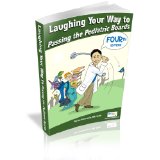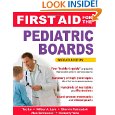January 27th, 2012
Finding My Center…Court
Gopi Astik, MD
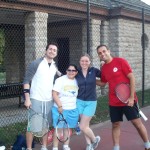 Nobody ever said that residency (or medicine in general) was easy. Still, I don’t think I expected so much of my time to be taken up by my job. Don’t get me wrong — I love what I do — but it’s not as easy as other occupations to “leave work at work.” As an intern, I was lost and confused many times about diagnosis and treatment plans for my patients. I’m not one to ask a lot of questions, so I took it upon myself to research these things after work. I usually made a to-do list of things that I did not know and had to look up and understand in the evening. I continued this habit throughout my residency. This was great for my learning but not so great for my personal life.
Nobody ever said that residency (or medicine in general) was easy. Still, I don’t think I expected so much of my time to be taken up by my job. Don’t get me wrong — I love what I do — but it’s not as easy as other occupations to “leave work at work.” As an intern, I was lost and confused many times about diagnosis and treatment plans for my patients. I’m not one to ask a lot of questions, so I took it upon myself to research these things after work. I usually made a to-do list of things that I did not know and had to look up and understand in the evening. I continued this habit throughout my residency. This was great for my learning but not so great for my personal life.
I was spending all day at work and then all evening thinking about (or preparing for) work. I didn’t have any time for me.
With the time commitment of the daily job for medical personnel, it is very important to find things to do outside of work to both relieve stress and give the mind some rest. I have been playing tennis as long as I can remember. I played competitively as a child and into high school and college. During medical school, I gave it up. I can’t say that it was only because I didn’t have time but also because I stopped enjoying it. I am a competitive person by nature and I think I was trying to challenge myself academically and put personal fitness on the back burner.
Near the end of my final year of residency, I started to notice the tennis courts at my apartment again. I started going out on the court by myself to practice my serves for 20 minutes here and there and I realized how much I missed playing. I found a group of residents who also play tennis and we started playing together as often as possible. We would meet at the park directly after work and play for 1-2 hours. Not only did this build camaraderie between coworkers but it was a great stress reliever and good exercise. I know not all people relieve stress with physical activity, but as recently reported in Journal Watch, even 15 minutes of low-volume activity can significantly lower mortality.
Playing tennis again was my way of “centering myself” and setting aside time for me again. I have seen positive improvements in both my attitude and productivity at work and at home. I’d love to hear what activities do the same for you.
December 16th, 2011
Be All That You (and the Program) Want You to Be!
Gopi Astik, MD
Interview season is in full force at UMKC. I never realized before how much work goes on behind the scenes to prepare and conduct these interview days, but I sure do now! As a Chief Resident, I schedule residents to attend the applicant dinners, lunches, and tours, and to spend time with the applicants our lounge. This makes the actual interview days go by much smoother, because two of us are present at all times to speak to applicants and answer any questions.
I’m always fascinated by applicants who go through medical school later in life. Since I started at the UMKC 6-year BA/MD program, I really had no real-life experience when I went through this process. I’ve met many applicants who have had previous careers and decided, after years of being in the work force, that they wanted to pursue medicine. I really admire people who take the risk (and pay cut!) to go back to school to fulfill their goals. As someone who conducts interviews, I can attest that these applicants often are very prepared and are great to speak to. I look forward to talking to them about their previous endeavors and what exactly made them come back to medical school. I always ask if it was worth it, and everyone says yes … then again, I am interviewing them for a job, so who would say no?
I’m fairly new to “this side” of the interview process, but I wanted to share some tips that I’ve thought of so far for any current applicants. I’ve adapted some of these from the AMA website as well.
- Be on time – Whether you know it or not, the day has a schedule that many people rely on. If you are going to be late due for any reason, let somebody know. We have had applicants email a few days before their interviews to request a phone number for somebody in the program — just in case they get lost or have any issues. This shows us they are prepared and want to keep us informed if anything comes up.
- Research the program – It’s a given that somebody is going to ask you why you chose to interview with their program. If you have done your research, you will have an informed answer. Even if you are interviewing at your “home” program, know the details about what has changed or is changing to make sure your interviewers know you were paying attention.
- Look your interviewers in the eye and offer your hand – As a girl, I was never really taught ha
 ndshake etiquette, and I don’t even know if I have that down now. Many people will ask for a firm handshake, but I won’t comment on that. Please look the interviewer in the eye even it its not in your nature to do so normally. When interviewees don’t look at me, it makes me feel awkward myself — I feel like they are being evasive for some reason.
ndshake etiquette, and I don’t even know if I have that down now. Many people will ask for a firm handshake, but I won’t comment on that. Please look the interviewer in the eye even it its not in your nature to do so normally. When interviewees don’t look at me, it makes me feel awkward myself — I feel like they are being evasive for some reason. - Prepare a few questions beforehand – We HATE asking you repeatedly if you have any questions, but we have to do this to fill the silences. We want to make sure you are informed before you leave. We are available all day to ensure that you can assess our program adequately. If you have a few generic questions prepared, you can ask them throughout the day whenever things get quiet — it makes you appear interested. It’s also nice to have questions ready, because each of your interviewers will likely ask you if you have any! Play this one by ear: If your interviewer appears rushed or mentions they have to be somewhere, he or she might not be the best person to ask that extra question, but most people would appreciate answering one question at the end of the interview.
- Interact with the other applicants who are interviewing with you – We don’t just want to hear what you have to say; we are also watching how you interact with your peers. In our program, being social is very important because we tend to spend a lot of time together outside of work. Being antisocial or extremely introverted is a negative in our eyes.
- DON’T use your phone or computer on your interview day!!!! – This boggles
 my mind. It is rude and unacceptable. I hate when people do this. Even if you think we won’t notice during the tour or during a quiet moment – we always see it. If you need to check in for your flight or make a quick call, ask the Chief Resident or coordinator who is with you if you can step away for a moment. Better that they think you are being formal in asking rather than the alternative — thinking you are rude and judging you for being on your phone or laptop.
my mind. It is rude and unacceptable. I hate when people do this. Even if you think we won’t notice during the tour or during a quiet moment – we always see it. If you need to check in for your flight or make a quick call, ask the Chief Resident or coordinator who is with you if you can step away for a moment. Better that they think you are being formal in asking rather than the alternative — thinking you are rude and judging you for being on your phone or laptop. - Don’t opt out of any of the interview day– Even if you are interviewing at your home program, go on the tour. Along with this, I would also say not to make travel arrangements that force you to leave early. Not being present for part of the day automatically makes me think that you aren’t interested. Even if you have walked those halls 1000 times, if you were truly interested in our program, you would take the tour and be excited about it. We understand sometimes you can’t schedule travel perfectly, so, if this happens, let the coordinators know as soon as you book your flight so they can plan your day in advance.
- Thank the program coordinators – As the Chief Resident, I get many thank you cards/notes from applicants, and I understand why, but the true credit for the interview day should go to the program coordinators. They work so hard behind the scenes to make sure everything goes smoothly for you and for everyone involved. They are the unsung heroes of this process and deserve a lot more credit.
I hope some of these tips help those of you going through this process. Any career decision is important but don’t stress yourself out. I suggest making a list of all of the things you would like your future program/workplace to have. At the end of every interview, write down what the program had and didn’t have on your list. This makes the decision easier at the end, and, who knows, you might end up choosing a program that it fits all of your needs/expectations but that wasn’t on your A list. I’d love to hear what other interviewers look for and recommend.
November 1st, 2011
A Little Advice Goes a Long Way
Heidi Zook, MD
 In an effort to get in shape, I decided to start working out with a personal trainer. Before the training sessions started, we met to talk about my general health. When it comes to health, I feel like I know what I’m doing — I’m a physician! Of course I know how to eat healthy and how to take care of myself (whether I choose to follow my own advice or not is another story). The discussion began with her asking whether I was taking any supplements. (A little background: I bought vitamin D supplements about a year ago, fully intending to take a daily dose. Unfortunately, the bottle is still nearly full.) The trainer advised me that vitamin D is beneficial in many ways and that I should be taking a daily vitamin D supplement. Did I already know that vitamin D offers multiple health benefits? Yes. Do I speak with patients routinely about their vitamin D intake? Yes. Do I strongly encourage my patients to take vitamin D? Yes. Did I start taking vitamin D daily only after my new trainer told me to do so? Yes. So, why did her telling me do to something I already know I should be doing get me to do it? That question doesn’t have such a straightforward answer. It seems ridiculous; I knew better than that! I guess the important thing is that she got me to do it, along with several other healthy behaviors that she reminded me about.
In an effort to get in shape, I decided to start working out with a personal trainer. Before the training sessions started, we met to talk about my general health. When it comes to health, I feel like I know what I’m doing — I’m a physician! Of course I know how to eat healthy and how to take care of myself (whether I choose to follow my own advice or not is another story). The discussion began with her asking whether I was taking any supplements. (A little background: I bought vitamin D supplements about a year ago, fully intending to take a daily dose. Unfortunately, the bottle is still nearly full.) The trainer advised me that vitamin D is beneficial in many ways and that I should be taking a daily vitamin D supplement. Did I already know that vitamin D offers multiple health benefits? Yes. Do I speak with patients routinely about their vitamin D intake? Yes. Do I strongly encourage my patients to take vitamin D? Yes. Did I start taking vitamin D daily only after my new trainer told me to do so? Yes. So, why did her telling me do to something I already know I should be doing get me to do it? That question doesn’t have such a straightforward answer. It seems ridiculous; I knew better than that! I guess the important thing is that she got me to do it, along with several other healthy behaviors that she reminded me about.
The idea of counseling in the clinical setting always seemed a bit redundant to me; I mean, who DOESN’T know that smoking leads to cancer, heart disease, and emphysema? Undergoing counseling myself with my trainer made me realize the power of instruction. When something is directed at you personally, and it’s coming from someone who is knowledgeable on the subject, it truly is powerful. This idea is reflected in a recent summary in Journal Watch General Medicine, “Counseling Can Encourage Intake of Cholesterol-Lowering Foods” (Oct 1, p. 153). Simple dietary counseling on two occasions led to a 13% reduction in mean LDL cholesterol levels compared with only a 3% reduction in the placebo group. Even better: the researchers found no significant difference in LDL reduction in the group who were counseled seven times versus the group who were counseled only twice. This article, along with my own experience, helped me reflect on what I can offer my patients: A little advice goes a long way.
October 20th, 2011
Shifting Times
Gopi Astik, MD
 Anyone involved in academic medicine probably is aware of the new ACGME duty-hour restrictions that went into effect on 7/1/2011. For those of you who aren’t, the new guidelines state that PGY1 residents cannot work for longer than 16 hours straight. If they do work longer, they require strategic uninterrupted naps. The restrictions on PGY2 and PGY3 residents are less stringent, but the total consecutive hours that a PGY2 (and beyond) can work was lowered from 30 to 28. One other change is that residents are mandated to have 8 hours off, and recommended to have 10 hours off, between shifts. As one of the chief residents when this change occurred, I really want to share my thoughts about it.
Anyone involved in academic medicine probably is aware of the new ACGME duty-hour restrictions that went into effect on 7/1/2011. For those of you who aren’t, the new guidelines state that PGY1 residents cannot work for longer than 16 hours straight. If they do work longer, they require strategic uninterrupted naps. The restrictions on PGY2 and PGY3 residents are less stringent, but the total consecutive hours that a PGY2 (and beyond) can work was lowered from 30 to 28. One other change is that residents are mandated to have 8 hours off, and recommended to have 10 hours off, between shifts. As one of the chief residents when this change occurred, I really want to share my thoughts about it.
For our program, these new rules have meant a transition to shift work on all days of the week. We have had night float for the past 5 or 6 years, but we had overnight “long” calls during the weekends. I can see both good and bad things about this new call change. We avoid some resident fatigue, because interns work only 16 hours maximum. The problem is that, in order to accommodate for the shifts, giving interns an entire weekend off is very difficult. The Golden Weekend is becoming somewhat of a myth to our intern class. Transitioning to a shift-based call system also points out major flaws in our handoff process. We have noticed that our “checkouts”/handoffs were not relaying the needed information and, as a program, we’ve been trying various things to improve this process.
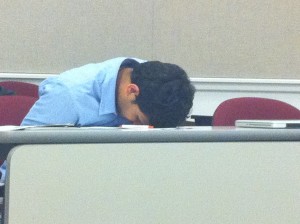 One thing I ask of every resident reading this page is — be nice to your chief resident! We didn’t make this rule, nor did we have any input into the decision, but we have to enforce it. The more restrictions that the ACGME puts on resident work hours, the more complaints I hear from attending physicians about having to pick up the slack. We often do not have the manpower to ensure that every service will have a “full team” of interns and residents to complete daily work, and we have to rely on staff physicians to fill the service gap.
One thing I ask of every resident reading this page is — be nice to your chief resident! We didn’t make this rule, nor did we have any input into the decision, but we have to enforce it. The more restrictions that the ACGME puts on resident work hours, the more complaints I hear from attending physicians about having to pick up the slack. We often do not have the manpower to ensure that every service will have a “full team” of interns and residents to complete daily work, and we have to rely on staff physicians to fill the service gap.
Our job to ensure that residents do not work more hours than they are allowed and, thus, avoid citations against our program. Problems arise mostly when residents who are on weekday call (which ends at 7PM for us) delay leaving because of notes, orders, or patient care issues. If a resident does not leave until 9 or 10PM, they cannot come back into the hospital until 7 or 8AM. This means that those residents probably have not seen all of their patients before rounds begin, and the responsibility falls on other residents or the attending physician. I realize that this issue is a culture shock for some of the older physicians who “used to walk to work in a foot of snow uphill both ways,” but these are the rules, and we all have to live by them. So, please, cut your chief a break!
October 17th, 2011
Checking It Twice
Gopi Astik, MD
 I always remember my mother trying to teach me things I didn’t agree with. Being the bigmouth that I was (am), I would voice my disagreement, and she would tell me that, one day, I would tell my kids the same thing. I, of course, did not agree. I felt the same way about some of the tedious things I learned to do in medical school. I didn’t understand why my attending always made me recheck blood pressures on patients when I saw them, after a nurse had already done that precise thing. I would recheck the blood pressure and mindlessly report the measurement back to my staff. I started noticing that the levels were usually lower when I checked them again in the room, and I thought this was because I was so good at checking them.
I always remember my mother trying to teach me things I didn’t agree with. Being the bigmouth that I was (am), I would voice my disagreement, and she would tell me that, one day, I would tell my kids the same thing. I, of course, did not agree. I felt the same way about some of the tedious things I learned to do in medical school. I didn’t understand why my attending always made me recheck blood pressures on patients when I saw them, after a nurse had already done that precise thing. I would recheck the blood pressure and mindlessly report the measurement back to my staff. I started noticing that the levels were usually lower when I checked them again in the room, and I thought this was because I was so good at checking them.
The study regarding clinic-based BP measurement discusses this issue in more detail. It states that many people who are diagnosed with hypertension by clinic-based measurements alone are not truly hypertensive. It proves the validity of “white coat hypertension” and the importance of serial blood pressure measurements prior to initiation of therapy. If patients are not truly hypertensive, we are putting them at risk for hypotension with BP-lowering medications and subjecting them to risk for adverse effects and the associated cost-burden.
I was recently in clinic and asked my student what a patient’s blood pressure was when she rechecked it in the room — to which my student rolled her eyes and went back to check. I had to laugh — I realize how things really do come full circle.
September 30th, 2011
Hello, Journal Watch Readers!
Heidi Zook, MD
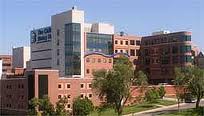 Hello Journal Watch readers! My name is Heidi Zook, and I am thrilled to have the opportunity to share my thoughts and opinions with all of you for the next year. I am one of the current chief residents at the University of Missouri-Kansas City, so my viewpoint is that of a junior faculty, recent resident, and current chief resident. Just like our other chief resident blogger, Gopi Astik, I am a proud Kansas Citian. I grew up in Shawnee, Kansas, which is a suburb of Kansas City. For medical school, I attended the 6 year combined BS/MD program at the University of Missouri-Kansas City. I loved it so much that I stuck around for internal medicine residency and an additional year as a 4th-year chief resident. My training has taken place at two hospitals: Truman Medical Center, a county hospital serving the underprivileged, and Saint Luke’s Hospital, a nationally-recognized tertiary care center. I have had the opportunity through my training to see many types of patients, as well as many styles of communication and perspectives on healthcare.
Hello Journal Watch readers! My name is Heidi Zook, and I am thrilled to have the opportunity to share my thoughts and opinions with all of you for the next year. I am one of the current chief residents at the University of Missouri-Kansas City, so my viewpoint is that of a junior faculty, recent resident, and current chief resident. Just like our other chief resident blogger, Gopi Astik, I am a proud Kansas Citian. I grew up in Shawnee, Kansas, which is a suburb of Kansas City. For medical school, I attended the 6 year combined BS/MD program at the University of Missouri-Kansas City. I loved it so much that I stuck around for internal medicine residency and an additional year as a 4th-year chief resident. My training has taken place at two hospitals: Truman Medical Center, a county hospital serving the underprivileged, and Saint Luke’s Hospital, a nationally-recognized tertiary care center. I have had the opportunity through my training to see many types of patients, as well as many styles of communication and perspectives on healthcare.
During my time as a blogger, I hope to share my perspective as a fairly new physician, which I hope many of you will be able to relate to. We are all lucky to be able to combine science and art into our everyday practice as physicians. I want to discuss both the science that drives our clinical decision-making as well as the art that makes our jobs so enjoyable. One of my favorite patients during the course of my training was a 96-year-old man who was admitted to the hospital with acute and chronic systolic heart failure and a history of aortic valve replacement. He was very active and independent. He sat me down one day and said how thankful he was that he received an aortic valve replacement at the age of 92 because he had been having so much fun playing in his polka band for the past 4 years. That experience taught me that intervention isn’t always about age, but about functionality. It helped to mold me into the clinician that I am today. Please share some of your favorite patient encounters that taught you about how to practice medicine, how to communicate, or how to enjoy life!
September 26th, 2011
Hello, Everyone!
Gopi Astik, MD
Hello, everyone, my name is Gopi Astik, and I am one of the internal medicine chief residents at the University of Missouri-Kansas City. Our program has 4th-year chiefs, so I have completed my residency and am excited to be able to share the experience of my transition from resident to new faculty with all of you. Even as I write that, I cannot believe that I am now a staff physician.
I should start by telling you a little about myself. I am from Warrensburg, Missouri, which is about an hour east of Kansas City. I went to the University of Missouri-Kansas City for the 6 year BA/MD program, and I graduated in 2008. I decided to stay close to home for my internal medicine residency and then decided to stay AGAIN for my chief residency. What can I say? I love Kansas City. Many of you probably haven’t been to this area, and I want to tell you that it’s a beautiful place with lots of things to do. It’s a big city with small town feel … but, then again, I’m extremely biased.
 This photo is from the Country Club Plaza at Christmas time. The holiday lights are lit during a ceremony on Thanksgiving – it’s amazing! There’s more than this to Kansas City, but I’ll sprinkle the details around during my time as the resident blogger.
This photo is from the Country Club Plaza at Christmas time. The holiday lights are lit during a ceremony on Thanksgiving – it’s amazing! There’s more than this to Kansas City, but I’ll sprinkle the details around during my time as the resident blogger.
I plan on writing about how the articles in Journal Watch affect my clinical practice, along with giving my personal experiences of my chief residency. I look forward to hearing your thoughts and questions as well. If there’s anything in particular you would like to hear about, please share your questions and comments. I am eager to share my experiences with all of you!
September 8th, 2011
Finding the Learning Sweet Spot
Sarah Bergman Lewis, MD
Dr. Bergman Lewis is a senior resident in Pediatrics at Seattle Children’s Hospital. By way of introduction, I am finishing my pediatric residency at Seattle Children’s Hospital, have enjoyed being a resident editor of Journal Watch Pediatrics and Adolescent Medicine for the past 3 years, and will write as an interim blogger for the next month or so. Greg left big shoes to fill but I’ll do my best to pave the way for the next resident blogger.
I am in the agitating phase of studying for a test — I am loosely aware of what looms ahead but have not strategically plunged into studying. The General Pediatrics Boards are about 5 weeks away. Similar to my view of all standardized tests, I’ve dreaded this test since the first time I heard about it. I have been trying — with varying levels of success — to adapt the “right” attitude: Focus more on learning material that I think a “good pediatrician” should know and less on being bitter about how much it costs. (The worst part about failing is that I’d have to pay again next year!)
Given my imminent trip back to the books, I have been reflecting on how learning happens in medical school and residency. Before I entered medical school, I was involved in launching a middle school where I taught sixth grade for 2 years. At the Seattle Girls’ School, we taught an integrated curriculum. For example, the first trimester’s theme was inventions, and core subjects like reading and math were taught under this umbrella theme. We explained to parents that by mirroring how we learn naturally, neural connections are made, and students stay passionate about learning.
When I entered medical school, I experienced an environment that was quite far from facilitating natural learning. In fact, the first year of medical school took the most natural “integrated curriculum,” — the human body — and artificially broke it down into histology, pathology, anatomy, and biochemistry. Without a strong science background or honed study skills, I struggled and barely eked by in my classes. It was not until clinical clerkships that I started to believe I might be smart enough to be a doctor. As I began caring for patients, the connections I couldn’t make from a PowerPoint presentation began to appear. I often wish I could go back to the first 2 years of medical school now that I have a scaffolding of patient encounters on which to hang my knowledge.
Learning in residency looks different than it did in medical school. For those like me who learn from hands-on patient interactions, there is endless material, but little time to process it. Although it may feel more comfortable to learn from a prepared noon conference lecture, do you learn more from the patient care call that causes you to leave the lecture? The answer to where this sweet spot of learning and hands-on experience lies is a moving target, and different for all of us.
The intensity at which our highest quality of learning occurs is another variable. Some of us may absorb information best when presenting a patient on rounds, voicing a plan despite being less experienced than anyone in the audience. For others, being in the hot seat short circuits all neural connections. During residency, I experienced some of my best learning when I was post-call on rounds but had gotten at least 30 minutes of sleep (this has interesting implications for new work hour restrictions that may take people off post-call rounds).
The fact is, we all learn differently and most of us spend much time worrying about if we are learning enough. If only we’d give ourselves a collective break. We are all naturally curious people who want to be the best doctors we can be. We cannot help but learn. We should have a bit more faith in the process and trust that when we’re spit out the other end of residency, we will have acquired enough knowledge to be good doctors.
Of course, our formal training represents the tip of the iceberg of what we will eventually learn. It does seem like developing good learning habits from the get-go is important. For this reason, in residency we should be paying as much attention to how we learn as what we learn. For what it’s worth, here’s some advice for learning that I wish I’d been given:
- Set up habits that encourage, and don’t squash, your natural curiosity: Look up answers to your questions, not just subjects you are instructed to read about.
- Break learning down into small nuggets. Small nuggets of learning add up and the more you crack open the book or open the online journal, the more habitual and less cumbersome this process will feel.
- Pay attention to what learning medium works for you. Do you prefer print or online material? Are lectures more helpful? When possible, study material in the right medium for you.
- Select one patient per rotation and write down what they taught you.
- Start some sort of filing system for helpful articles or handouts — even if it’s just Google Docs or a box.
- Register for free e-mail alerts from Journal Watch. Read the rest of the relevant Journal Watch publications when you can — the format is perfect for residents and provides brief summaries of relevant studies and take-home messages provided by well-respected clinicians.
- Convert the time you use asking yourself if you are learning to try some of the above suggestions. And by the way, the answer is yes, you are learning a lot…enough.
As residents, one thing we do is try hard. So, we will try hard to keep learning and trust that we are learning while caring for patients. Speaking of trying, I need to face the music and set up a study schedule for Boards so I can get it over with. I will try and stay focused with the right attitude and view studying as a last episode of a sitcom when I will revisit the patients I have encountered in training. Now, if I can just figure out the right soundtrack. . .
August 24th, 2011
The Whatever-Works Parenting Plan
Sarah Bergman Lewis, MD
Dr. Bergman Lewis is a senior resident in Pediatrics at Seattle Children’s Hospital. By way of introduction, I am finishing my pediatric residency at Seattle Children’s Hospital, have enjoyed being a resident editor of Journal Watch Pediatrics and Adolescent Medicine for the past 3 years, and will write as an interim blogger for the next month or so. Greg left big shoes to fill but I’ll do my best to pave the way for the next resident blogger.
When my daughter, Anya, was a few months old, I remember reading a blog post to my mom that I found when, for the first of many times, I Googled “baby bedtime routine.” One father wrote: “The solution to bedtime is that I crawl in the crib with my baby, then when she is asleep, I crawl out.” My mom and I laughed and rolled our eyes. Fast-forward 1 year and I’m blearily gazing into the crib, patting Anya to sleep, wondering if it would hold my weight. Sleep is only one area in which being a mom has humbled me and challenged the tenets of my pediatric education.
When the time to expand our family coincided with the last year of my residency, my husband and I knew it was not going to be easy. However, I did not foresee all the ways it would shape me as a physician. As a pediatrician-in-training, I knew the “right” advice to offer in each situation, but it turns out that the “right” advice carries little weight in the minute-to-minute nuances of parenting.
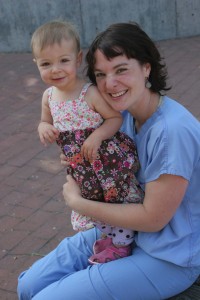 We found our stride as a family only when I started accepting that we would have our own unique challenges as well as our own solutions and started doing what worked for us. We hunkered down and my world became very narrow — hospital or home. My husband and I tried to listen to each other and tune out all the “shoulds” that made us feel inadequate. We were blessed to have local family and actually moved in with my mom for the year. The bills piled up and the voice mailbox filled. We co-slept, not for philosophical reasons, but because it felt necessary. I was tired and couldn’t spend the precious time at home with Anya listening to her cry from the other room. Anya stayed up late when I was on the wards and slept all afternoon with me post-call. When I was on nights, we took two daytime naps together. This was not the sleep-nap routine I had outlined for parents in clinic, but Anya’s adaptability gave us long hours together snug in bed, breast-feeding after 30 hours apart. By paying attention to Anya’s cues instead of outside advice, we found our own rhythm and Anya thrived — and my husband and I survived!
We found our stride as a family only when I started accepting that we would have our own unique challenges as well as our own solutions and started doing what worked for us. We hunkered down and my world became very narrow — hospital or home. My husband and I tried to listen to each other and tune out all the “shoulds” that made us feel inadequate. We were blessed to have local family and actually moved in with my mom for the year. The bills piled up and the voice mailbox filled. We co-slept, not for philosophical reasons, but because it felt necessary. I was tired and couldn’t spend the precious time at home with Anya listening to her cry from the other room. Anya stayed up late when I was on the wards and slept all afternoon with me post-call. When I was on nights, we took two daytime naps together. This was not the sleep-nap routine I had outlined for parents in clinic, but Anya’s adaptability gave us long hours together snug in bed, breast-feeding after 30 hours apart. By paying attention to Anya’s cues instead of outside advice, we found our own rhythm and Anya thrived — and my husband and I survived!
Once I became more comfortable in our own ever-changing “routine,” I began to recognize allies within medicine. I felt less isolated as I shared more about our solutions. After attending a Grand Rounds presented by the medical examiner on the dangers of co-sleeping, I sheepishly admitted to my intensive care attending that we spend the majority of time co-sleeping. “So do I,” she responded, “you have to when you’re away so much, right?” The fellow and the pharmacist both chimed in with their own stories of co-sleeping. It felt like we were talking about brewing gin during Prohibition.
My own experience adapting to motherhood while being a resident convinced me that our job as primary care doctors is to lay out the safe — but wide — framework within which patients can find their own path. It is tempting to preach guidelines and be quick with advice but more valuable to tailor our expertise to empower individuals to find their own way. Particularly in light of my experience as a parent, I will strive to have conversations with patient families that are nonjudgmental, honest, and practical.
I salute my fellow resident parents out there. Keep up the good work crafting a home life that is uniquely right for your family. I would love to hear your stories from the trenches.
August 17th, 2011
What Keeps You Charged?
Sarah Bergman Lewis, MD
Dr. Bergman Lewis is a senior resident in Pediatrics at Seattle Children’s Hospital.
By way of introduction, I am finishing my pediatric residency at Seattle Children’s Hospital, have enjoyed being a resident editor of Journal Watch Pediatrics and Adolescent Medicine for the past 3 years, and will write as an interim blogger for the next month or so. Greg left big shoes to fill but I’ll do my best to pave the way for the next resident blogger.
Just over a year ago, my daughter Anya arrived and has made my residency experience both brighter and more challenging. Her arrival also left me with three extra rotations to make up for maternity leave. Starting in the fall, I will be doing locums work in two primary care clinics. So I stand with one foot in residency and one foot in the real world. It’s a unique vantage point and I appreciate the opportunity to share a few of my observations and would love to hear about yours.
When I realized that I had to extend my residency, I decided to take a month off while my classmates graduated. I spent the month preparing for my sister’s wedding, taking Anya to music class, and trying to be normal. It was fun — but not easy — to throw on the brakes after 7 years of working hard. But I adjusted, as did my loyal husband, and by the time I was starting to feel acclimated, it was time to go back to work. The weekend before returning, I felt nauseous most of the time. On Monday morning, I nursed my daughter while she was still asleep, put on my pager, and walked out the door.
I was starting an adolescent rotation in a gynecology clinic with an attending I had looked forward to working with. My mind was still at home as I followed her to see our first patient who turned out to be a patient I knew. She was a previously healthy 16-year-old who presented to the emergency department last year with fulminant meningococcemia. She sat before us in her electric wheel chair, status post four-limb amputation, reporting that she needed to be “checked out” as part of her evaluation for kidney transplant (she is dialysis dependent secondary to her horribly long illness). In this young woman’s many encounters with the medical world, she has never failed to amaze me by her optimistic and down-to-earth spirit. After rattling off the 15 medications she is taking, we chatted about how she hopes to couple a back-east college tour with a Make-A-Wish Foundation trip to meet Beyoncé in New York. She said she was scared to return to high school for the first time but relieved that her friends were still there. I walked out of the room feeling noticeably lighter. The sense of dread and apprehension I felt going back to work was replaced by inspiration from this resilient young person.
It is easy during residency to get bitter and complain — it is after all a difficult time — but it is not necessarily helpful. Throughout residency, patients such as this young women have restored my energy when I needed it most. This intimate human connection is what drew me to medicine and has kept me on this path. During my first rotation senioring on the wards, feeling somewhere between a secretary, tour guide, and camp counselor, I felt dull and tired. Only when I started seeing patients with the medical students did I get my spark back. For all of us, that spark is essential. For some, it may be cutting in surgery, while for others, it may be building a differential diagnosis on a puzzling patient. Whether you are an intern who is scared of making a mistake, a junior resident who is worried that you aren’t scared of making a mistake, or a senior resident who is pondering if you have learned anything at all, notice what recharges you and seek it out.
This photograph was taken by a fellow resident from our call room at Harborview Hospital, the county hospital where we do our rotation in pediatric burns and trauma. I have stared at this view post-call and find the majestic mountain steadying after a crazy night. Rounding during pre-dawn hours, we spend plenty of time in windowless rooms, but sometimes we happen upon a view that is magical. Staying charged can help you not miss the magical views when they come along.
I would love to hear what keeps you charged.

